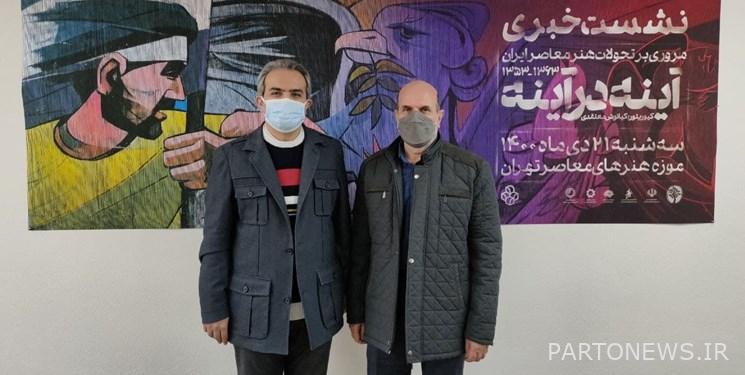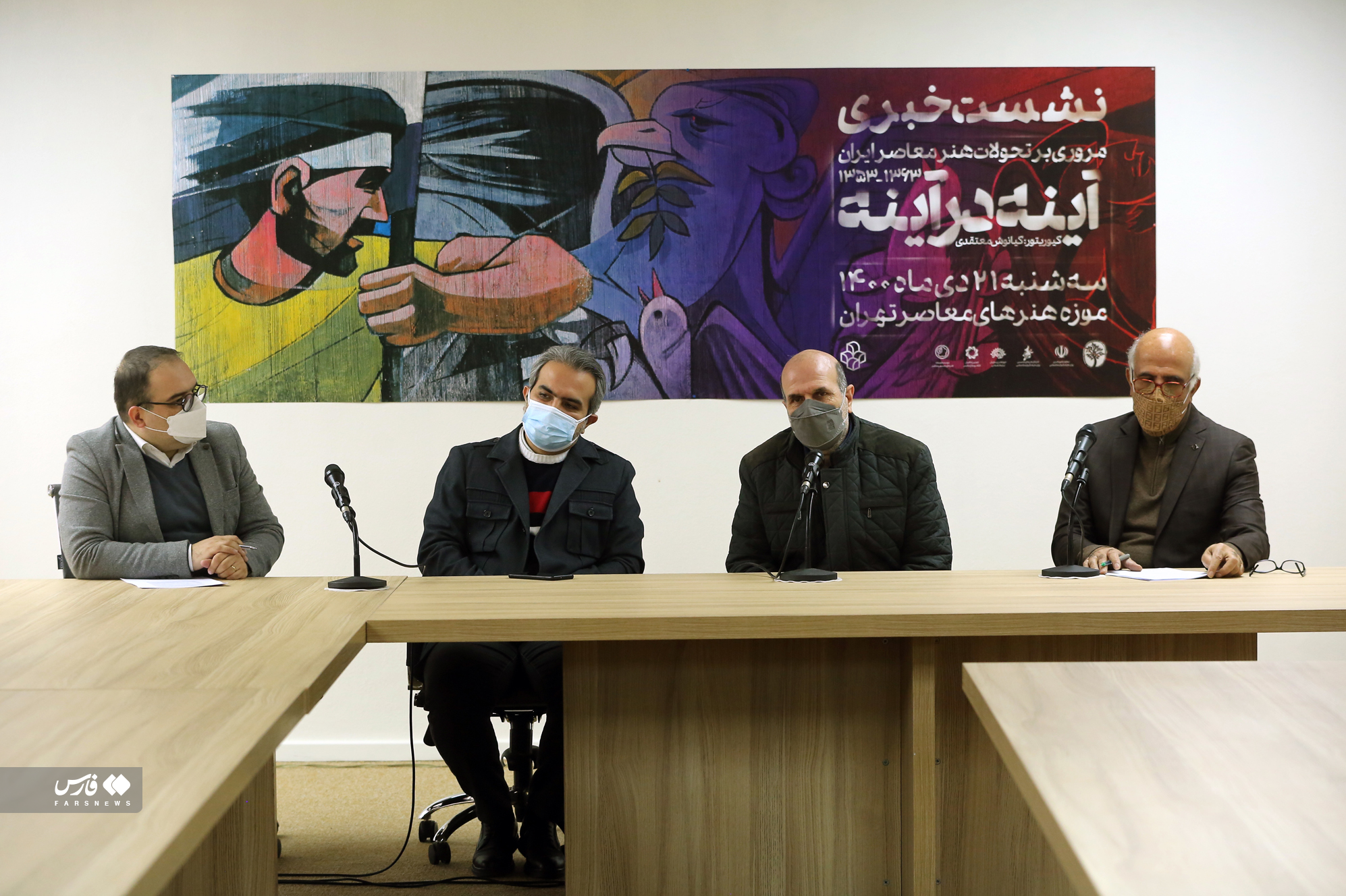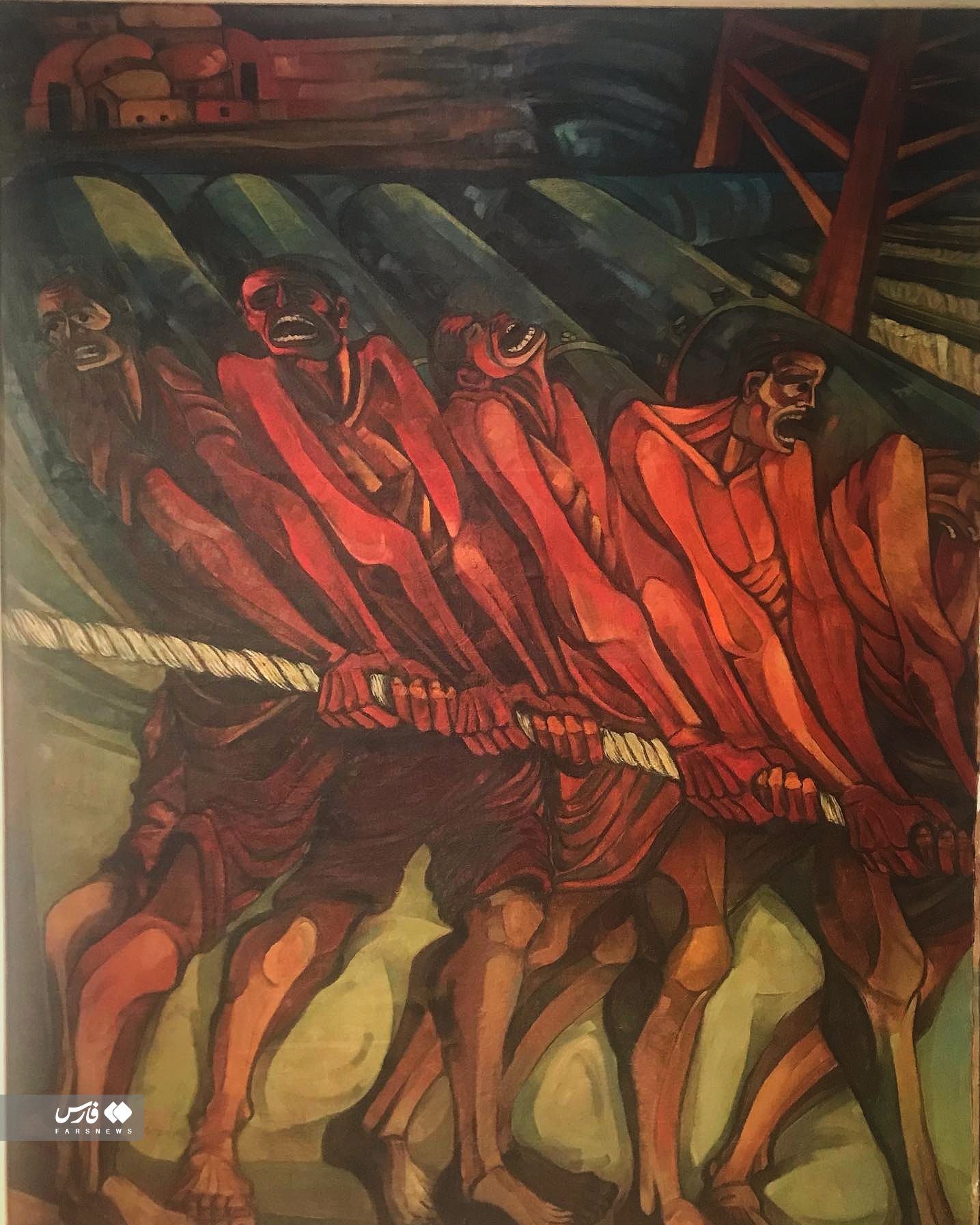40 unseen revolutionary paintings; From the work of Ayub Emdadian to Sirus Moghaddam + Photo

According to Fars News Agency’s visual correspondent, the press conference of the “Mirror in the Mirror” exhibition was attended by Ehsan Aghaei, director of the Tehran Museum of Contemporary Art, Seyed Abbas Mirhashemi, secretary general of the 14th Fajr Visual Arts Festival, and Kianoosh Motaghedi, curator of the “Mirror in the Mirror” exhibition. Contemporary Iran 1363-1353) was held at the Museum of Contemporary Art in Tehran.
At the beginning of the meeting, Mr. said: “We decided to expose the unseen treasures in addition to the new exhibitions.” The exhibition “Mirror in the Mirror” begins from the period of protest (Constitutional Revolution) and independent artists and continues until the Islamic Revolution and reaches the holy defense. In the 1940s we have protest art with literature and then in the 50s it is connected to visual art.
The director of the Tehran Museum of Contemporary Art explained about “Mirror in the Mirror”: “Such exhibitions in Iran usually look at the content of protest art, so we decided to deal with it from an artistic point of view.” With this in mind, we will continue other exhibitions entitled “Mirror in the Mirror”.
He pointed out: After the Museum of Contemporary Art in Tehran, the treasures of the Art Center and the Association of Revolution and Holy Defense have the largest share, and a number of single works, for example, have been received from the garden of the Negarestan Museum and the treasures of some artists such as Ayub Emdadian. The oldest work belongs to him in 1353.
“In my opinion, the works that have been in the treasury of the art field since the 50s and 60s are very important and golden, unlike the works that have been added to the treasury of the art field in recent years,” he said.
* We respect the intellectual rights of artists outside Iran
The head of the Tehran Museum of Contemporary Art, in response to the question “How does the museum deal with the works of artists who are in the treasury of the art field but have a relationship with this center,” said: Do not show it in a museum, but it can say do not show it in another museum. However, we usually try to respect the intellectual rights of the artist. For example, Mr. Emdadian, who now lives in France, I talked to for hours until they agreed to have their work exhibited.
He continued: Mr. Bahman Boroujeni, who is not in Iran, has a 100-meter painting, which is the largest painting in Iran, and if it is not in this exhibition, it is due to lack of space. We even talked to Mr. Massoud Saad al-Din, who is not from Iran, who welcomed the exhibition and said that it has about 100 revolutionary works, and coordinated with his brother in Semnan to donate them to the Museum of Contemporary Art in Tehran.
At the end of his speech, Aghaei reminded: The new approach of Fajr Visual Arts Festival is a research approach without any bias and it defends these activities. The current reading of the museum from the mirror to mirror exhibition would not have been possible without the approach of Mr. Mirhashemi.

* We do not include our taste in research work
Referring to the reformist view in the structure of the Fajr Visual Arts Festival, Mirhashemi said: “The research approach is one of these corrective cases and we hope this will be repeated in different periods to fill many gaps in the visual field.”
He continued: “The cooperation between the Fajr Festival of Visual Arts and the Museum of Contemporary Art in Tehran, helped us to achieve valuable events, and I have to thank Mr. Aghaei.”
Mirhashemi stated: When it comes to research work, we are not allowed to involve our own tastes and we should look at it with an open and academic eye.
The Secretary General of the 14th Fajr Visual Arts Festival stated: When it comes to research work, we are not allowed to involve our own tastes and we should look at it with an open and academic eye. Therefore, if there is no work in this exhibition, it has not been treated with taste.

The work that “Cyrus Moghadam”, the director of Paytakht TV series, was shot in 1977
* Half of the works of “Mirror in the Mirror” have not been seen so far
Then Motaqedi, the “Mirror in the Mirror” exhibition revolver, said about the idea of this exhibition: “In the course of the flow of contemporary Iranian art, we have currents that turn into schools.” In the early 1950s, after the birth of the Saqakhaneh school, the protest art movement was born under the social art. We consider the formation of the protest movement and finally the revolutionary art in this exhibition.
He added: “Our chosen period is a decade and the fact is that we have not seen the fields of revolutionary art before.” In this exhibition, based on the historical course, we will display paintings and calligraphy. About half of the works are seen for the first time and it is an important narrative of Iranian painting in a certain historical period that is accompanied by a national expressionism.
The director of the exhibition added: “We have also seen the art of coffee houses as a national species in this exhibition.” The dimensions of the works are very large and they have been done on very large canvases. We have also paid attention to works of art influenced by other revolutions, such as Mexico and Russia. We have also used photos and posters of the revolution to complete the narrative.
He added: “We have two important elements in the art of revolution, the people and the leadership.” The encounter of artists and their type of aesthetics with these two themes is interesting, and for this reason, we have portraiture in this exhibition. About 90 paintings, photographs, posters and graphic works have been seen in this exhibition.
According to Fars, the “Mirror in the Mirror” exhibition will open on Tuesday afternoon, January 19, at the Museum of Contemporary Art in Tehran.
Tehran Museum of Contemporary Art is located on North Kargar Street, next to Laleh Park. The museum reopened last year after 32 months of renovation. This reopening was accompanied by the display of 705 works from the living donation collection of Manijeh Mir Emadi to the museum.
* Art group suggested news
End of message /
You can edit this post
Suggest this for the front page
.

